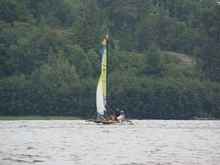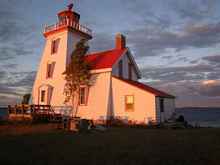|
To Part One
To Part Three
August 4-9 - Windrider 17 Tri - ONWARD
“This trip included the most harrowing/exhilarating
3.5 miles I ever sailed”. - Joe
DAY TWO: In the AM we got packed up. Rick had
discovered that he had a slow leak forward through a screw hole.
He used his electric bilge pump and got quite a lot of water out.
We sailed back down to Kagawong and did the tourist thing: went
to a fine local museum, got hot dogs from the cart run by a high
school kid, hiked up to Bridal Falls, and waited out a rainstorm
in the ice cream shop.
Our plan was to sail for Little Current at the southeast end
of the North Channel about 20 miles directly west. Joe put a reef
in the main at the dock and then shook it out just before we left.
On the first day I had just followed Rick’s lead. I hadn’t
really gotten oriented. But today I knew where we were going;
I had my charts sorted out and our destination plugged into my
charting GPS. As we rounded Trudeau Point at the head of the bay,
the wind was directly astern and building, and I passed Rick’s
boat with Joe close behind.
 |
Mudge Bay (pic by David). |
I should mention that our WindRiders were configured quite differently.
I had worked to make mine as close to a sea kayak as possible.
I preferred being hunkered down and steering with my feet. I had
a ½ spray skirt and a small windshield in the rear cockpit,
and a large windshield in the front cockpit to deflect waves and
spray. I hadn’t put on the full spray skirt or the front
cockpit cover; I mistakenly thought that the conditions wouldn’t
warrant it. Joe’s boat was similarly equipped but without
the rear windshield. We both had rigged up tillers so that we
could steer from forward as needed. Joe is a better sailor than
I am and is often out in front, but for this trip he had only
a rudimentary small scale chart and his GPS hadn’t loaded
detail charts correctly, so he let me take the lead on this leg.
 |
Joe buttoned by for heavy weather (pic by David). |
Rick’s boat was a different kettle of fish. He was inspired
by the Corsair F-27. He has custom aluminum and net seating on
the sides of both the cockpits. He steers by hand with a tiller,
his feet securely planted in the rear cockpit. He has replaced
his flimsy plastic floor with an attractive wooden floor with
easy access to bilge storage. I have to haul myself out of the
rear cockpit to move about the boat, he is already “on deck”
and can quickly move about the boat as needed. His most radical
change was to cut off his deep keel and replace it with a centerboard
and add a transom-mounted rudder. The main advantage is to reduce
his draft significantly and make the boat point higher. On this
trip his boat was riding a low in the water with David aboard
and extra camping gear.
 |
Rick and David heading into Mudge Bay. |
The WindRider provides a wide and stable platform when sailing
downwind. On my boat the amas are 12 feet apart. With its relatively
deep and long keel well-aft in the boat the steering is sure and
stable, even when surfing down the waves. I started out using
the full main and the reacher set on the bowsprit. Soon I furled
the big head sail, and deployed the jib. Finally I was down to
full main alone. As the wind built, the waves, with almost 100
miles of fetch, built as well. I would sail up on a wave, with
the crests at times more than 3 feet above the bow, and, as the
bow lifted on the wave, push through. A few times the water broke
around the windshield. The boat surfed down the face of the wave,
once hitting 12.5 knots. I wasn’t exactly white knuckling
it – I was exhilarated – but I found myself wishing
I had a reef in the main, so that I would feel more confident
about sailing closer to the wind if needed, or slowing down to
wait for the other guys to catch up. With a full main I felt like
all I could do was keep on keeping on and hope that nothing required
me to go forward (like a snagged line) or to change course.
I was in radio contact with Joe, and kept him informed about
rocks and upcoming buoys. At one point he said that he was going
to depower the main by pulling it in some and get himself slowed
down. Unbeknownst to both of us a drama was unfolding in Rick’s
boat. His outhaul was disconnected. As he was securing it, the
boat jibed and the boom caught him right between the eyes, knocking
him across the boat. He said if the seat hadn’t been there
to catch him he would have been knocked overboard. He was stunned
and considered calling Joe and I and asking to alter course and
head north to more sheltered water, but he and David soldiered
on.
 |
Little Current (pic by David) |
As we approached the more sheltered water near Little Current
the waves abated and I was able to wait up for Joe. The wind continued
to build with occasional stronger gusts. I had a scare when I
was lying a-hull furling my main and realized that I was being
swept by the current towards the bridge. I got the motor started,
got sorted out and tied up at the gas dock. Rick and David swept
in and with a shout that the drawbridge was opening in 8 minutes.
There was not a moment to be lost. I quickly cast off and motored
for the bridge. We were headed for Heywood Island, six miles beyond
the bridge, where Rick said there was a protected anchorage with
a sandy beach where he could pull up his boat and fix his slow
but persistent leak.
But Heywood Island exists only in my imagination. We never made
it. The gods of the wind and waves had a different plan for us.
Once clear of the bridge we set sail, again not choosing to reef.
As we stood off for the cut between the Strawberry Island lighthouse
and Garden Island Reef the wind intensified, Joe shot through
the cut. I saw Rick’s boat nosedive over a wave and round
up. He looked OK so I put my boat just off the wind, climbed out
of my rear cockpit, and went into my reef-the-main-while-underway
drill. The boat will jog slowly to windward with main out and
the tiller hard to windward. I use a tiller tamer to keep enough
tension on the steering yoke to hold a course.
 |
Strawberry Island Lighthouse |
With the boat now sailing well under reefed main alone I noticed
that Rick was headed into the wind under full main and jib but
making little progress. I thought that he was waiting up for me,
to make sure I was OK, and felt a flash of appreciation. As I
sailed up to him I saw David frantically bailing the boat with
a sauce pan. Turns out that when the boat nosedived, they took
a wave that filled the cockpit, and when they rounded up, another
wave had filled the rear cockpit. They were now low enough in
the water that they couldn’t bail fast enough to keep the
waves from filling the boat. His motor, mounted on the stern,
had started but then had dropped completely underwater. Rick was
sailing slowly south hoping to eventually get into the lee of
Manitoulin Island and out of the wind and waves. And I think he
might have made it.
What was wonderfully comforting was that the amas were providing
enough buoyancy to keep Rick and David afloat. I took my sail
down, got my trusty 2 HP Honda fired up and with a lot of shouting
attempted to tow his boat ama to ama. The boat was so heavy that
the best I could do was pull both of us around in a circle. So
we got a bow line secured and began to tow, aiming for some sheltered
water in the lee of a dock a ways to the south. We made some progress,
but were getting set sideways by the wind and waves, and it was
clear that we were going to be on some nasty looking rocks in
short order. We were able to get his bow swung around, adjust
our course and head for the cut by the lighthouse. After a minute
or so, even with my engine screaming at full power (can a 2 HP
Honda scream – maybe it was a high pitched putter) the rocks
didn’t look like they were getting any further away. But
the GPS assured me that we were making good 1.2 knots to windward.
 |
The Gaffney family and friends take us in. |
As this was happening, Joe was experiencing his own drama. He
got his boat under control and ducked into a cove in the lee of
Strawberry Island. After 10 minutes, with no sight of us, he got
worried. He got his motor fired up and tried to round the point
in the teeth of the wind, but his motor got dunked, sputtered
and died. He then set off on foot across the island to try to
establish visual contact. We made the turn downwind to pass by
the lighthouse and our speed picked up. As we entered the cut,
we saw a bunch of kids and adults at the lighthouse waving to
us and motioning us to enter the sheltered cove in the lee of
the point. As we approached the dock Joe came bounding out to
meet us. The kids were chattering excitedly. The adults got us
tied off. This was the Gaffney family and friends. We were their
guests for the next day and a half. Once out of the waves, the
boat bailed out easily, and we moved to an adjacent cove where
Joe had taken shelter and began to sort ourselves out, lick our
wounds and compare stories.
Continued next month...
*****

|

